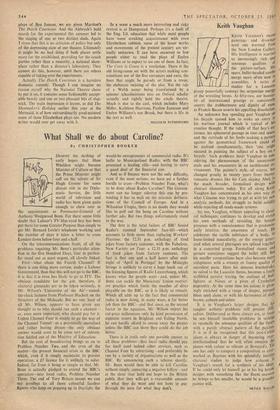Keith Vaughan
An unknown boy speeding past Vaughan Oa his bicycle caused him to make an entry his wartime journal which is typical of creative thought. If the riddle of that boy's ea' istence, his ephemeral passage in time and space, and the certitude of his limbs making a pattern against the geometrical framework could all be realised simultaneously, then 'one might succeed in painting the subject of a boy on. a bicycle.' Such problems beset Vaughan in con- sidering the phenomenon of the anonymous male and his encounters in an earthbound en' vironment. The painter's style, of course, has changed greatly in twenty years from thorny, romantic dramas like his Cain slaying Abel, the much • broader, formalised design with abstract elements today. Yet all along Keith Vaughan has concentrated in his own way 011 what Cdzanne was trying to get at with, his nevi analytic methods, his struggle to build soliditY while rejecting all ready-made systems. So, too, Vaughan, without appealing to classi' cal techniques, continues to develop and enrich his own methods of revealing the human presence with a consciousness that is predomin' antly intuitive, the awareness of touch. fic celebrates the tactile substance of a body, its loose-limbed muscularity; or the energy getter" ated when several physiques are spliced together in a concerted group. Formalised stance and gesture sometimes suggest the ballet still. Bul his smaller compositions have also become morc, voluptuous with a creamy or foamy quality 0. succulent paste. Here his sinuous brushstroke, so suited to the Laocoon theme, becomes a freelY scribbled pattern tracing the outlines of bull' fighters at Nimes or a piece of Cymbeline pageantry. At the same time his colour, is gloW' ingly enriched with a range of deeper, intense blues used alone, or with his harmonies 'of dari brown, auburn and ochre. It is in Vaughan's larger designs that hi5 tougher cesthetic. problems still present culties. Deliberated as these always are, at thrts he sets himself insoluble problems in seeking to reconcile the sensuous qualities of the figtq° with a purely abstract pattern of flat patch' It is as if he recognised that this post-CubiSt idiom is always, in danger of becoming ovqr intellectualised that he will often sweeten planes with colour as vibrant as Bonnard's. Y9' one has only to compare a composition as over" worked as Baptism with his splendidly incisiv,a charcoal studies to judge how arduous As Vaughan's search for a synthesis of his ideas, If he could only let himself go in his big heroic designs with something like the' fluent masterl he brings to his smaller, he would be a,grander painter still. NEVILE WAILP


































 Previous page
Previous page